I would like to share with you everything I have learned about plowing snow on a Large-scale outdoor layout over the past 12 years. I use battery power, so I have to admit I have no experience plowing with track power. I love plowing snow with my trains. Many of you know my railroad runs every day, even if it's only in my mind. I keep the story going. I will admit that I have actually gone to work late on mornings when light powdery snow is falling that is perfect for plowing. I think those of us that have outdoor railroads in the snow belts have one big benefit over our counter parts in the south. While there are days that we can't run outdoors because of winter, there are those rare few days that make it worthwhile. My neighbors have teased me and made fun of me for plowing while they shovel their driveways. I had one good neighbor give me a plastic baggie full of change once. She told me the neighborhood chipped in to buy the plow crews hot coffee for all their hard work. She was laughing as she walked away. The next storm I used a small trowel and plowed one strip down her driveway with no foot prints showing and left a thank you note from the plow crews. Well enough about my mental stability.
If you want to try plowing snow on your railroad the most important thing you will need is a plow. You can buy a narrow gauge type plow from Aristocraft. If you like to plow with steam engines it is best if they are heavy or have traction tires. Diesels are easy to plow with.
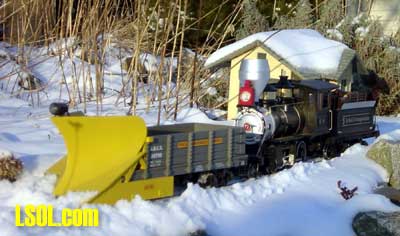
This plow was built from their kit. I used regular plastic USA trains trucks and metal wheels instead of their cast white metal side frames that were extra. I also added a 1/2" thick piece of scrap brass inside on the floor for weight. I also used a thin .020 sheet of brass for the plow blade instead of the wood piece that came in the kit.
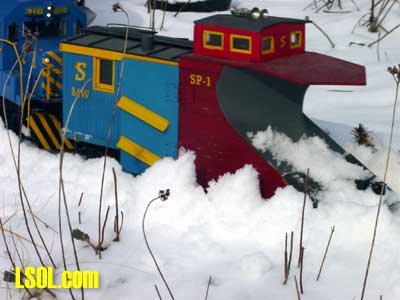
Most import it to acclimate your equipment. If you bring your engine out of the warm house and put it on the cold rails - it's like putting your tongue on a metal pole when it's below freezing, you just don't. If you do the warm wheels will cause condensation with the contact of the cold rails and then either stick or just form ice on the railhead. It will then be hard to get your train going. 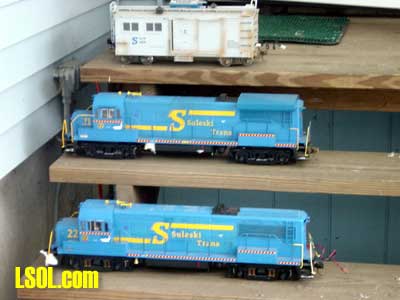
I put the cars on my wood steps for about 20 minutes prior to commencing plowing operations. I also use a broom to brush off the starting area where I am going to put my equipment on the rails. The broom is one I leave outside to brush off my cars. If the snow isn't light enough to sweep with a broom it will probably be too wet to plow anyway. Best plowing is down with light dry powdery snow.
When ever possible I always try to take photos from an angle that doesn't include houses, street, or fences. Also photos from eye level look more realistic than angles from above.
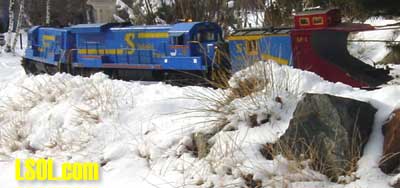
I usually use two or three engines just because I like the look better. You can use just a single engine especially if it has traction tires. 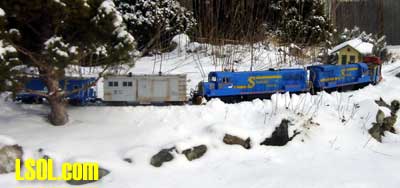
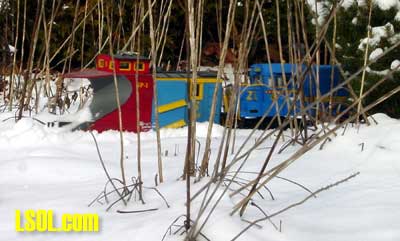
The plow consist usually includes a battery boxcar from the work train for power and at least a caboose. Sometimes I put a bunk car and a kitchen car in the plow extra for the story. This way crews can get a meal and have a place to sleep in case they don't return.
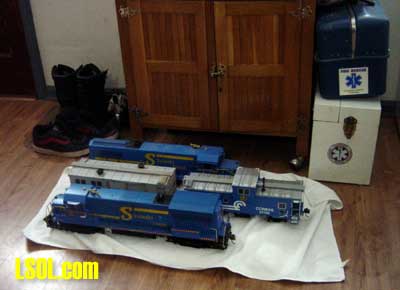
After plowing it is important to dry off all your equipment, I do this by placing a bath towel on the floor and letting the trains sit on it while the snow melts and water runs off. If there is any snow on top I brush that off so it won't melt inside the trains.
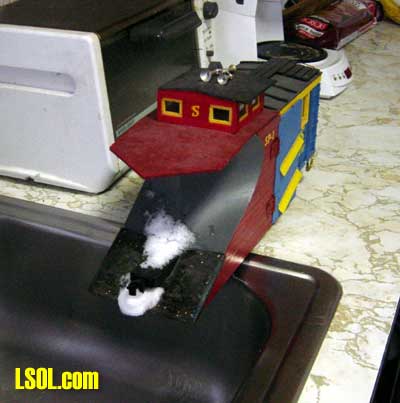
If the plow is covered with too much snow, I put it in over the kitchen sink and let it melt off there. Of course I always try to plan my plowing operations so as not to interfere with my wife's kitchen use. It's very important for the plowing crews to work well with other departments.
Here is an mpeg of plowing on January 17, 2005 after an overnight snowstorm. - Seven Second Movie (mpg)
To really give you the benefit of all the years of experience we have allowed LSOL to interview the Chief of Plow Operations on Suleski Transportation, J. Frost. Read on...
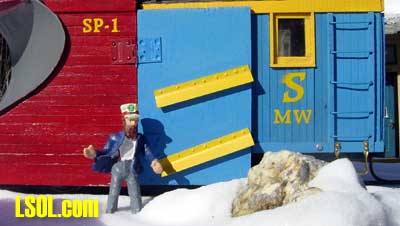
LSOL: "Hi, Scott Suleski said if we wanted to know about plowing that you were the man to ask."
J Frost: "Well he would, even though he owns the railroad, I take care of all plowing operations. Although I had nothing to do with that mishap when we loaned the plow out one winter, but I won't get into that."
LSOL: "There are a lot of other railroads around the world that can benefit from your experience and we are hoping to pass it on."
J Frost: "Thanks I'm very flattered."
LSOL: "We let's start by asking you about your name."
J Frost: "That always comes up, the J doesn't stand for Jack, it is JAY Frost, and no I don't have any relatives named Jack. Let's just skip making fun of my name and I'll tell you about plowing."
LSOL: "That seems fair, so what are your vast secrets?"
J Frost: " Well I would hate to disappoint you, but most of it may seem like common sense. The most important thing is to acclimate your equipment. If we just drive the plow consist out of the warm engine house all the windows will fog up and we won't be able to see a thing. Also warm wheels on cold rails don't mix. You need to add weight to any type of plow so it stays on the track. Gravity helps, so if you have grades - plow them down hill if possible."
LSOL: "You're right that does seem like common sense"
J Frost: "Couplers help also. Body mounted couplers will tend to keep your plow on the tracks along curves and when pushing large amounts of snow out of cuts. Also if you have to back up and get speed to plow forward again they will work better.
LSOL: "What else can you tell us?" J Frost: "It also helps to plow during or right after the storm. If you wait too long the snow will tend to pack down and be too hard to plow. If it ices over, forget it send the pay loaders out instead."
LSOL: "Are there any Company secrets that you can tell us?"
J Frost: "No secrets, once I tried some Teflon spray on the plow blade to see if it made the snow fly off any smoother. It didn't make any improvement so I never tried again."
LSOL: "What can you tell us about your plowing equipment?"
J Frost: " Well we use a gull wing wedge plow. You can see here:"
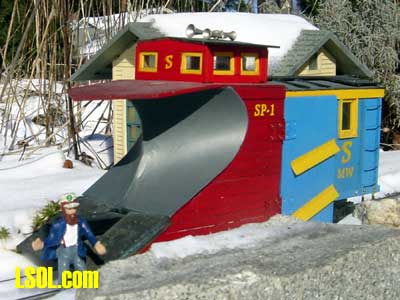
"It is made from an old caboose. The plow blade is v-shaped and designed to throw snow to each side of the track. This type is best used for plowing single track. We have been working on Mr. Suleski to get us equipment to build two side throw wedge plows. These are built on the same principal except the plow blade is designed to throw snow either left or right only. These types of plows are used for plowing double track so you don't throw the snow back onto the track you already plowed. If you have a left throw on the front and the right throw on the back you can cut you plowing time in half. Of course you'd need extra crews if you don't want to stop and keep changing cabs and plows. We just need to get priority over painting diesels."
LSOL: "What do you do now for double track?" J Frost: " We just make a few extra runs to clear it."
LSOL: "Why do they call it a Gull-Wing Wedge Plow?"
J Frost: "First it is a wedge plow because it has no power of its own. It needs to be pushed by our diesel engines. Just like the old wedge plows built on the flats or gons. It also has wings on the side that we can control to plow a wider swath through the snow. We need to do this on curves especially because the Intermodal well cars are long and might not make it around a curve if the snow wall was too close to the track. We pull the wings back to clear signals and such. The name Gull-wing came because these plows were first built and used in New England. Gulls are usually the only birds you see around in winter time."
LSOL: "When you say it is pushed, does that mean you don't drive it"
J Frost: "That's right, during plowing operations you are sitting up in the crows nest with your partner. One person controls the front blade up and down, mainly for grade crossings, and the wing on his side. The other crewmember controls the wing on his side and the horn. We use a radio to converse with the engine crew, but we also have a back-up system code with the horns that is still used from the days before radios. The power is usually two or three diesels. Sometimes we plow with a single unit when snow is light. We also usually carry a boxcar with parts and a caboose. If we are going to be out longer because of the storm we will also add a bunk car and a kitchen car from our work train."
LSOL: "So how come there are no windshield wipers on the windows like there are on the diesels?" J Frost: "Some railroads tried them, but they would get damaged or when they got iced over they wouldn't work. We have added a heating unit to the plow and have heated glass windows. It's just like the rear defrost on a car only with a bit more power to it."
LSOL: "You said you added a heater?"
J Frost: "That's right, back when I worked for the B&M there was just a pot bellied stove like in the old cubbies for warmth. However with all the banging back and forth a few railroads burned their plows when hot coals spilled out of the grates onto the wooden floors. They soon made rules that stoves had to be cold during plowing operations. That made it like an icebox while you were plowing. Many men on the extras board would take their phone off the hook when they saw it was snowing and knew they were due for a call in."
LSOL: "Really, you mean they wouldn't want to come in to plow?"
J Frost: "Most people thought you were crazy if you like plow extra duty."
LSOL: "Why is that?"
J Frost: "Think of it as being in the front seat of a roller coaster, it was very cold, and at every grade crossing you would hit not one but two snow banks from a highway plow that would jar the plow and shake every bone in your body right down to you back molars. If you forgot to pull the wing in and you took out a signal you were in real trouble. Also if you hit a bank of hard packed heavy snow at 20 mph and came to a jarring stop, you would just have to back up and then hit it again and again until you were through. Sometimes the plow would derail when it hit ice, so you had to be good with a re-railer or swallow your pride and call the wreck train crew. Calling the wreck train was something no one wanted to do, they can be very expensive."
LSOL: "So it wasn't fun?" J Frost: "For most people it wasn't, for me it was a blast. I love sitting up there with the white plume of snow pouring out each side. Seeing the countryside flash by all covered in its white blanket. I love the front seat, but roller coasters aren't as fun any more after being in the plow. I think that's why some people make fun of me and call me crazy."
LSOL: "Do you go out in every storm?"
J Frost: "I am always one of the two crewmembers in the plow on every extra. Wouldn't miss it for the world. I enjoy plowing the most out of all the different jobs I have held on the railroad. I think if you've never plowed snow with your railroad you don't know what you're missing!"
LSOL: "Well Jay thank you very much for your time, we really enjoyed sharing in your wealth of plowing knowledge. We think our readers will enjoy it also.
J Frost: "Well I am glad I could be of help. I could talk all day about plow operations, but I do have some maintenance to get to before the next storm. See you later."
LSOL: "Goodbye and thanks for your time!"
| snow plow |
| Scott, Great article, especially the interview. I see you use the counter to dry the plow. How did the wife react the first time you did this? LOL! I just might have to make one for next year. If I'd get my battery powered K-4 running in time I could see it pushing the plow. If not, my two rail powered GPs might work since they have capacitors in them for better power. Gary |
| gary condry - 12/31/2010 - 15:26 |
| Good tips |
| Great tips on acclimating the equipment, I would have never thought about that..I do store my equipment in the garage so it is one step closer to outside than the warmth of the finished basement...having just received 12+ inches the day after Christmas I was tempted to plow and run but had recently discovered some track issues. Thanks again! Evan |
| Evan Stone - 01/02/2011 - 19:27 |
Top of Page



